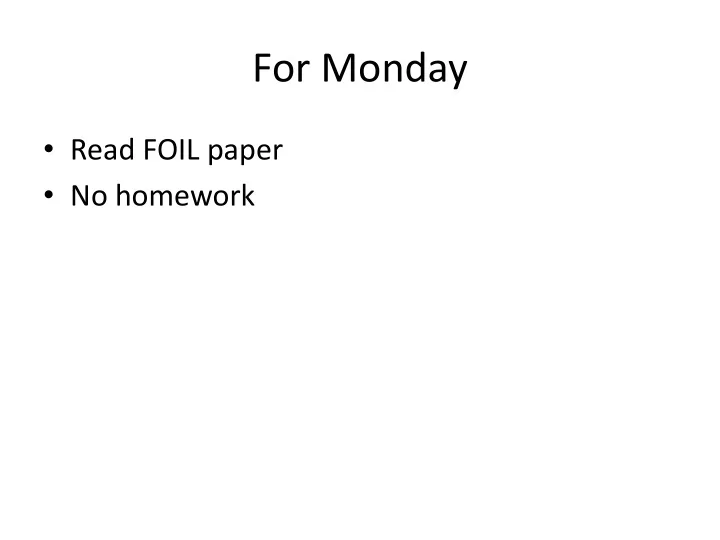

For Monday • Read FOIL paper • No homework
Program 2 • Questions?
Rule Learning • Why learn rules?
Proposition Rule Learning • Basic if-then rules • Condition is typically a conjunction of attribute tests
Basic Approaches • Decision tree -> rules • Neural network -> rules (TREPAN) • Sequential covering algorithms – Top-down – Bottom-up – Hybrid
Decision Tree Rules • Resulting rules may contain unnecessary antecedents, resulting in over-fitting. • Rules are post-pruned. • Resulting rules may lead to conflicting conclusions on some instances. • Sort rules by training (validation) accuracy to create an ordered decision list. • The first rule that applies is used to classify a test instance. red circle → A (97% train accuracy) red big → B (95% train accuracy) : : Test case: <big, red, circle> assigned to class A
Sequential Covering
Minimum Set Cover
Greedy Sequential Covering Example Y + + + + + + + + + + + + + X 9
Greedy Sequential Covering Example Y + + + + + + + + + + + + + X 10
Greedy Sequential Covering Example Y + + + + + + X 11
Greedy Sequential Covering Example Y + + + + + + X 12
Greedy Sequential Covering Example Y + + + X 13
Greedy Sequential Covering Example Y + + + X 14
Greedy Sequential Covering Example Y X 15
No-optimal Covering Example Y + + + + + + + + + + + + + X 16
Greedy Sequential Covering Example Y + + + + + + + + + + + + + X 17
Greedy Sequential Covering Example Y + + + + + + X 18
Greedy Sequential Covering Example Y + + + + + + X 19
Greedy Sequential Covering Example Y + + X 20
Greedy Sequential Covering Example Y + + X 21
Greedy Sequential Covering Example Y + X 22
Greedy Sequential Covering Example Y + X 23
Greedy Sequential Covering Example Y X 24
Learning a Rule • Two basic approaches: – Top-down – Bottom-up
Top-Down Rule Learning Example Y + + + + + + + + + + + + + X 26
Top-Down Rule Learning Example Y + + + + + + Y>C 1 + + + + + + + X 27
Top-Down Rule Learning Example Y + + + + + + Y>C 1 + + + + + + + X X>C 2 28
Top-Down Rule Learning Example Y Y<C 3 + + + + + + Y>C 1 + + + + + + + X X>C 2 29
Top-Down Rule Learning Example Y Y<C 3 + + + + + + Y>C 1 + + + + + + + X X<C 4 X>C 2 30
Bottom-Up Rule Learning Example Y + + + + + + + + + + + + + X 31
Bottom-Up Rule Learning Example Y + + + + + + + + + + + + + X 32
Bottom-Up Rule Learning Example Y + + + + + + + + + + + + + X 33
Bottom-Up Rule Learning Example Y + + + + + + + + + + + + + X 34
Bottom-Up Rule Learning Example Y + + + + + + + + + + + + + X 35
Bottom-Up Rule Learning Example Y + + + + + + + + + + + + + X 36
Bottom-Up Rule Learning Example Y + + + + + + + + + + + + + X 37
Bottom-Up Rule Learning Example Y + + + + + + + + + + + + + X 38
Bottom-Up Rule Learning Example Y + + + + + + + + + + + + + X 39
Bottom-Up Rule Learning Example Y + + + + + + + + + + + + + X 40
Bottom-Up Rule Learning Example Y + + + + + + + + + + + + + X 41
Algorithm Specifics • Metrics – How do we pick literals to add to our rules? • Handling continuous features • Pruning
Rules vs. Trees
Top-down vs Bottom-up
Rule Learning vs. Knowledge Engineering • An influential experiment with an early rule-learning method (AQ) by Michalski (1980) compared results to knowledge engineering (acquiring rules by interviewing experts). • People known for not being able to articulate their knowledge well. • Knowledge engineered rules: – Weights associated with each feature in a rule – Method for summing evidence similar to certainty factors . – No explicit disjunction • Data for induction: – Examples of 15 soybean plant diseases descried using 35 nominal and discrete ordered features, 630 total examples. – 290 “best” (diverse) training examples selected for training. Remainder used for testing • What is wrong with this methodology? 45
“Soft” Interpretation of Learned Rules • Certainty of match calculated for each category. • Scoring method: – Literals: 1 if match, -1 if not – Terms (conjunctions in antecedent): Average of literal scores. – DNF (disjunction of rules): Probabilistic sum: c 1 + c 2 – c 1 * c 2 • Sample score for instance A B ¬C D ¬ E F A B C → P (1 + 1 + -1)/3 = 0.333 D E F → P (1 + -1 + 1)/3 = 0.333 Total score for P: 0.333 + 0.333 – 0.333* 0.333 = 0.555 • Threshold of 0.8 certainty to include in possible diagnosis set. 46
Experimental Results • Rule construction time: – Human: 45 hours of expert consultation – AQ11: 4.5 minutes training on IBM 360/75 • What doesn’t this account for? • Test Accuracy: 1 st choice Some choice Number of correct correct diagnoses 97.6% 100.0% 2.64 AQ11 71.8% 96.9% 2.90 Manual KE 47
Recommend
More recommend